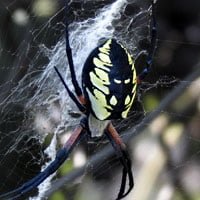Free shipping on USA orders over $129!


Last weekend the neighbor’s daughter came over to our house to deliver a message. We could tell she was a bit uneasy at our front door. She kept glancing over to the large spider web featured between two pillars of the porch, on which was sitting a beautiful striped garden spider.
“I don’t like spiders,” she told us.
“But this one is a garden spider,” I explained. “It eats the mosquitoes for us.”
“It does?” You could tell this benefit had grabbed her interest.
“Yes. See the zig zag on its web? Garden spiders do that.”
She followed us closer to the web, peering at it more intently.
“It will sit on the side of the web that the wind is blowing on,” my husband added. “So when the wind blows an insect into the web, the spider is in the right place to get it.” He held up his hand to test the wind direction, and we confirmed that the spider was indeed sitting on the correct side of its web to get its next meal more easily.
“But if you or I stand too close and don’t leave, it will move to the far side of its web, because it sees us as a threat.” I recounted the time my husband had been working in the garden beside the web and the spider had shifted its position.
By now the girl was closer, gazing at the spider, fascinated. “How do you know all those things?” she asked.
“You have to take time to watch them,” my husband answered with a smile.
Watch Patiently and Quietly
It’s a simple answer: take time to watch them. That’s what nature study is all about.
“Children should be encouraged to watch, patiently and quietly, until they learn something of the habits and history of bee, ant, wasp, spider, hairy caterpillar, dragon-fly, and whatever of larger growth comes in their way” (Vol. 1, p. 57).
But sadly, that simple practice is often elbowed aside in our crowded schedules. Either we don’t make the time to go outside at all or we rush out the door and hurry through the motions so we can get on to the next thing.
We and our children miss so much.
If there is one thing I want to emphasize to you this school year, it’s to slow down. Meaningful relationships are not formed in a hurry. And education is all about forming relations—with God, with our fellow man, and with creation around us.
Nature study is a prime opportunity to practice slowing down. You can’t force a creature to perform during the three minutes you have scheduled to watch it. Slow down. Live in the moment. Breathe. Notice what’s around you. Watch patiently and quietly.
Your spirit will be calmed.
And you’ll probably learn a bit about God’s creation too.
A Charlotte Mason Nature Study Handbook
If you would like more nature study encouragement in Charlotte Mason’s own words, Hours in the Out-of-Doors: A Charlotte Mason Nature Study Handbook is chock full of her inspiring and instructive quotes.
WIth Hours in the Out-of-Doors, you will
- Remind yourself of the wonderful benefits of nature study.
- Review the practical When, What, and How according to Charlotte.
- Get motivated to keep a nature journal.
- Most importantly, gain confidence to guide your children in forming relationships with nature.
“Let him know, with friendly intimacy, the out-of-door objects that come in his way—the redstart, the rose chaffer, the ways of the caddis-worm, forest trees, field flowers—all natural objects, common and curious, near his home. No other knowledge is so delightful as this common acquaintance with natural objects” (Vol. 2, p. 77).

Thanks for posting this. I appreciate it.
What a wonderful reminder, it’s so true nature does calm my spirit and I love seeing my children interact with God’s amazing creations ….. Love your website it has reassured me of my natural instincts as a homeschooler and calmed my spirit ! 🙂
Beautiful!!!